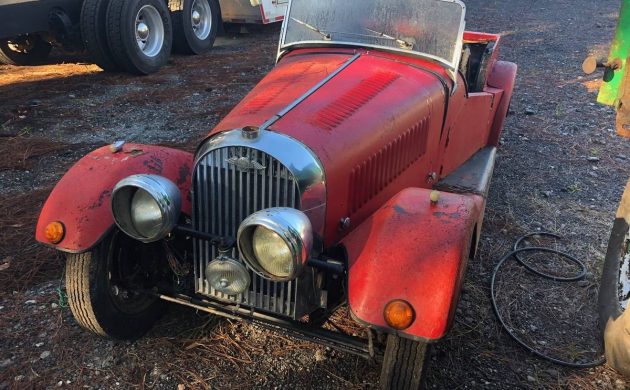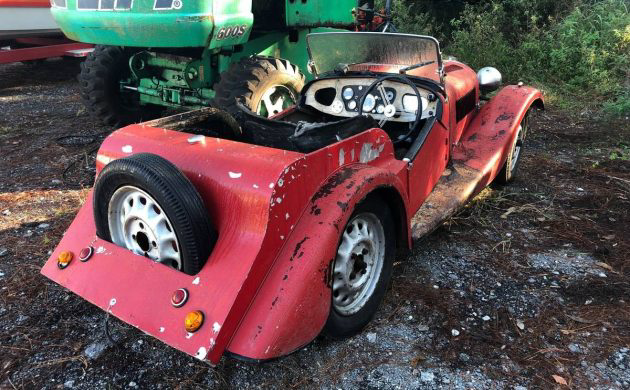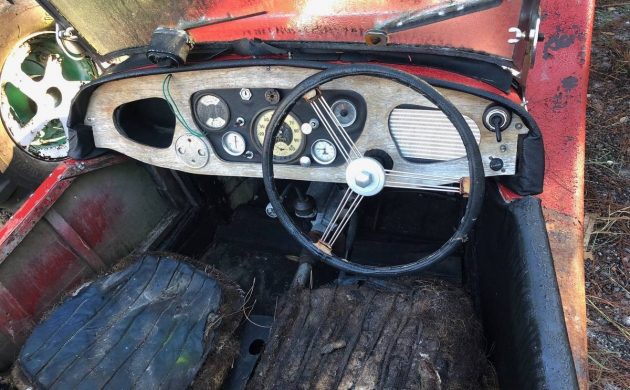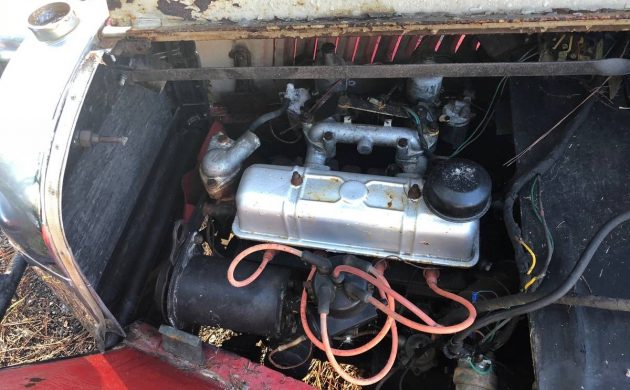We’re accustomed to seeing the iconic Morgan +4 come up for sale, as its general shape has remained the same for decades, much like the ubiquitous VW Beetle. This is a much earlier – and less often spotted – example, known as a 4-4, the first Morgan model to feature four wheels in concert with a four-cylinder engine. Spotted in Daytona Beach in Florida by Barn Finds reader Andria A., the Morgan can be viewed here on craigslist with an asking price of $8,500.
The 4-4 was a hit when it was introduced in the mid-30s, but production was soon halted to shift production efforts in support of wartime manufacturing. The numbers are hard to confirm, but production figures seem to be quite low for the 4-4, especially in drophead fashion like this car. Although the seller says it is a 1940 model, it would appear production stopped in 1939 before resuming in the mid-40s.
If the numbers I’ve found online can be trusted, just 58 DropHeads were produced between 1938 and 1939. The seller offers few details on how this one ended up in Florida, but it’s not far-fetched to believe a service member returning from the war may have brought it back stateside. It’s easy to understand why, as the Morgan could reach 80 m.p.h. and hit 60 in under 30 seconds – decent performance for the era, even if lethargic by today’s standards.
Although our British car fanatics will have to confirm what’s under the hood currently, the 4-4 left the factory with a four-speed manual transmission and a Coventry Climax engine delivering 34 b.h.p. Since these cars are popular among the vintage racing crowd, I’m sure upgrades are available. With a pre-war 4-4 a rare find practically anywhere but especially in the U.S., I can’t imagine this will stick around long. I’m surprised the publisher of Classic Motorsports, Tim Suddard, hasn’t grabbed this yet – it’s right in his backyard.






So where are the leather straps to hold down the bonnet?
Without those, this just not very appealing.
Al, you could pretty much get a Morgan to-order, just exactly the way you wanted it. I’m no expert, but I think the leather straps were probably an option, and I’m guessing that since these cars are so basic, you could probably just install a pair of them yourself. In fact, I’m sure you could get the Morgan factory to make up a set of straps and send them to you, or install them at the factory if you ship the car over.
I’m not sure what engine that is but it definitely isn’t a Coventry Climax. Climaxes from that era have spark plugs at the top with a couple of hump covers. Not quite a flat-head but close.
This has all the rocker-gear on top almost like the 2L Standard Triumph engine but it isn’t quite right. Generator placement is opposite that of Triumph motors. Valve cover reminds me of the MG XPAG engine but this one is way too big and they didn’t have direct drive fuel pumps. Tough call. Anyone else?
Its a Triumph Spitfire engine.
If you get in touch with the Morgan factory, they will probably get the original drawings of the car, out for you and tell you the specification they provided on the car when new. (And whether or not they put bonnet straps on).
They will also have their ledger there, to tell you exactly how many were made, and in what configuration.
https://www.morgan-motor.co.uk/
Hi Jeff,
This Morgan 4-4 is a bit of a bodged job. It’s not a drophead coupé which has a fixed windscreen and longer cowl high doors fitting the coupé designation. It is however, a roadster with ‘bodged’ doors (for wider driver passenger? or?) sweeping out from the cowl and joining the rear fenders in truly odd fashion.
The engine is a Triumph Spitfire or a modified Standard Ten 40hp 1267 which is correct for the ’45 – ’50 Morgan 4-4. The original Coventry Climax is a overhead intake side exhaust motor with a rather unique appearance as shown in the link that I’ve attached which also shows a proper prewar green roadster and a red drophead coupé. Another anomaly on this car is the single spare tire configuration.
https://revivaler.com/morgan-4-4-series-1-roadster/
Prospective buyer needs to fluently ‘speak’ early Morgan or have an expert inspect the car before purchase. Interesting, but, but…..
I’d vote Standard Ten. According to one source the ones in 38 switched from the Climax to the Standard. So it *could* be original. The front cooling housing is on backwards so it threw me off. Without a close inspection I can’t see anything distinguishing it between a Spitfire 1275 or the Standard Ten.
i’m almost certain that engine is an 1147cc from an early Spitfire. It sports the Spitfire 4’s dual SU HS2 carbs and intake manifold, as well as the oil filler cap to the rear of the engine. That would certainly be an improvement in performance over the original engine, but I suspect it can’t do much for the potential value of the car!
Same with what appears to be the gearbox that likely came from the same Spitfire!
Andy has spoken! If anyone knows all the minutia of little British motors it’s definitely Sir Andrew Mace, keeper of all Triumph Herald information!
Thanks bud! It’s been way too long since we spoke.
Between the engine swap and the truly oddball homemade rear clip… This may not be worth any thing to the purists but you could certainly have a lot of fun beating or around if the price was more like 4-5k.
Thanks for the compliment, Jim! And yeah, it HAS been way too long! But you raise an interesting point. In today’s hobby, where the “restomod” concept seems to be slowly overtaking the “restore to original” philosophy, why not take what’s here, fix what needs fixing, make it look nice again (note no suggestions of “patina” real, faux or in between from me) and enjoy the car — perhaps more so than it could be enjoyed as original? I don’t like to see original cars made into “restomods,” but this car already has suffered arguably irreversible modifications, so why not enjoy it for what it is now? (Hint: 99.98% of those who see the car will just give thumbs-up signs and “not be any the wiser”!)
I’m pleased to see that Andrew nailed it as an 1147 Spitfire engine as I have no experience with the early Spits. I took a look at the dash interior shot #4 on Craigslist advert tonight and one can clearly see the gear change extension and gear shift lever which further confirms Spitfire sourcing.
Reverting to “The Autocar” of “September 9th, 1938” they confirm that the OISE Coventry Climax would remain in use for the 1939 cars. Some of the mods for ’39 are quite interesting. For example the DHC engine is now mounted in rubber at four points. The “oil filter” – on the right (intake) side of the engine – “consists of a quick opening canister, into which a tin of oil may be inserted and left to drain into the sump.” The clutch is a dry plate Borg and Beck contained in a housing at the rear of the engine. “Although the gear box is attached to the engine, it is not directly so, for the connection consists of a stout steel tube, nearly 3in. in diameter, surrounding the clutch shaft. This arrangement brings the four-speed gear box well back into the car and gives a short ‘close up’ gear lever; also it avoids the need for a long propeller shaft.”
Also for ’39 the DHC has solid steel wheels with 5.50 x 16 tires vs the pressed steel spoked wheels of the roadster and four seater which sports (no pun intended) “4.50 by 17in. tyres”.
To confirm your Standard Ten comment, again from “The Autocar” “November 7th, 1941”; “Then not long before September, 1939 a Standard Ten engine was made available, with overhead valves, specially built for Morgan, and of 1,267 c.c., though still rated at 10 h.p. The war came almost on top of this developemnt, and only a few cars were actually produced…”.
Looks like a homemade rear body – flat panels, creased edges.
Kinda looks like a kit car. Sure there isn’t a VW motor in the back?
For that money, don’t be too demanding of originality.
Car is cheap. Restoration won’t be, but shouldn’t be hard.
That’s my first ever Morgan! I’m sure that’s ‘NPA 46’ last heard of in Georgia with a triumph Herald engine. If it is, and I’m sure it is, then she was sold in 1949 as rolling chassis when Morgans could not get steel. Apart from the botched rear end the bodywork is original done by some garage in the South of England in 1949. I bought that car in 1963 and it was the car that started my lifelong obsession with Morgans. The botched rear end is my first ever attempt at ‘panelwork’ aged 17 to replace the angular 4-seater body (hence the step on the rear wing) with the wood frame on the outside of the metal like a Woody!! It’s a piece of Morgan history, Somebody save the old girl. I’ve got some fuzzy period pics for any purchaser.